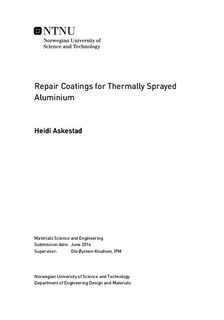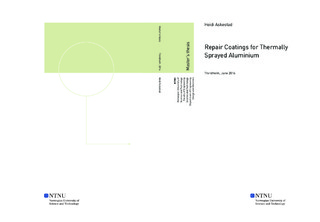| dc.description.abstract | Thermally sprayed aluminium (TSA) is widely used for corrosion protection on offshore installations. Rapid degradation of the TSA has earlier been discovered, if organic coating is applied on top of the TSA. In case of coating damages on the TSA, a duplex corrosion mechanism may occur. Due to access limitations with coating equipment or hot work limitations offshore, application of new TSA may be difficult. Therefore, it is necessary to develop a repair coating for TSA in connection with damage. The repair coating must provide corrosion protection without triggering the duplex corrosion mechanism and shall be applied without removing the intact TSA.
Eight repair coatings were tested on steel coated with TSA to determine the corrosion behavior in marine environment. Four possible protection mechanisms were considered: (1) cathodic polarization, (2) buffering capacity, (3) ability to release an aggressive environment formed under the coating and (4) electrical conductive coatings. The coatings contained anodic elements such as aluminium, zinc or magnesium, except for an inorganic copolymer coating and an MgO pigmented coating. A cyclic coating test was conducted for 20 cycles according to ISO 20340. Highest amount of corrosion creep for the TSA was seen for the Zn epoxy, the inorganic copolymer coating, the high Zn primer and the modified Zn epoxy. An average corrosion creep of approximately 5.1 mm was seen for the Zn epoxy. Due to corrosion products, blistering or cracking of the repair coat were seen for these coatings. The Zn-, MgO-, Mg- and Al-silicate showed promising results without blistering after the same test. The Zn silicate showed an average corrosion creep of approximately 0.6 mm, while the MgO-, Mg- and Al-silicate showed negligible corrosion creep.
Coating resistivity was measured by obtaining several electrochemical impedance spectra (EIS) over a period of time, and the open circuit potential (OCP) was measured. The zinc containing coatings were exposed for 134 days, while the MgO-, Mg-, Al-silicate and the inorganic copolymer coating were exposed for 81 days. All coatings showed an OCP more negative than -800 mV vs. Ag/AgCl, except for the inorganic copolymer coating. This coating had an initial potential of -430 mV vs. Ag/AgCl with decreasing development towards a more negative potential. The coatings that revealed blistering or cracking of the repair coating during the cyclic coating test showed generally higher impedance, compared to the silicate coatings that did not blister. An open coating structure was considered as the most important protection mechanism for a TSA repair coat. The protection mechanisms regarding cathodic polarization, electrical conductive coatings and the buffering effect were assumed less important compared to the open coating structure.
Crevice corrosion tests with different crevice designs were performed in order to have a short-term test for the TSA duplex corrosion mechanism. Further development of the test design is necessary before the mechanism can be investigated by this method. | |

